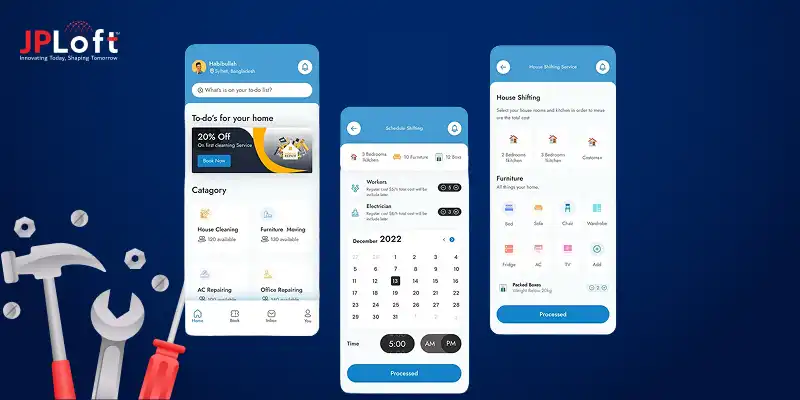“Failure is simply the opportunity to begin again, this time more intelligently.” — Henry Ford.
This quote perfectly reflects the reality of startups, especially in the handyman industry, where opportunity is high but risks are higher.
The handyman market is booming with on-demand services, yet many ventures struggle to survive beyond the first few years.
For entrepreneurs, understanding these challenges is critical to building a sustainable business. For investors, it reveals where to place bets wisely and avoid common pitfalls.
So, the big question is: Why does a Handyman Startup Fail?
The answer: Lack of research, poor scalability, weak retention, and ineffective planning often lead to failure.
Let’s learn it all in detail here.
Handyman Industry Overview and Market Stats
The handyman business is all about offering on-demand installation, repair, and maintenance services for homes and commercial spaces.
It encompasses tasks such as electrical work, plumbing, carpentry, painting, cleaning, appliance maintenance, and more smart home configurations.
Historically, the purview of local contractors, the business has crossed into online platforms, becoming more convenient and scalable.
Handyman apps are virtual platforms that bring customers into contact with certified professionals, offering features such as real-time scheduling, clear pricing, electronic payments, and user reviews.
This transformation not only enhances user convenience but also presents the possibility of growth for entrepreneurs and investors in the rapidly growing on-demand services market.
Let’s learn about the current handyman market statistics below.
-
In 2025, the global handyman service market is estimated to be valued at USD 530.5 million. By 2035, the market is projected to grow around USD 2,340.4 million, reflecting a CAGR of 16%.
-
The handyman service market has reached USD 448.89 million in 2024, and by 2033, this valuation is anticipated to reach USD 1,579.14 million.
-
Additionally, the handyman services market size is valued at USD 165 billion in 2023, which is projected to reach USD 33 billion by 2031, growing at a CAGR of 10% during 2024-2031.
-
Here, you should note that the global handyman service market is forecasted to expand at a CAGR of 12.2%, and thereby increase from a value of US $381.2 million in 2024 to US $853.3 million by the end of 2031.
Following these statistics, let's proceed with the reasons to evaluate “why a handyman startup fails?” in the following section.
Why a Handyman Startup Fails?
When you start an online handyman business, it is essential to evaluate the probability of leading the market and succeeding in it.
Yes, indeed, a positive mindset matters, but evaluating the risk of failure in the industry will help you manage resources wisely.
Hence, let’s get started with the list of “ reasons defining why a handyman startup fails?”
1. Inadequate Market Research
Poor market research is one of the leading causes of handyman startup failures. A lot of entrepreneurs take for granted demand without considering local demographics, competition, and pricing standards.
Startups end up overspending in low-demand markets or failing to spot lucrative service categories in the absence of hard data. Proper research into the behavior of customers, service gaps, and seasonal trends is important for long-term stability in the handyman business.
2. Weak Value Proposition and Differentiation
A common handyman startup mistake is launching without a clear, unique selling point. If your app or service offers nothing new compared to TaskRabbit or Thumbtack, customers have no reason to switch.
Failing to highlight benefits like faster booking, trusted professionals, or transparent pricing leads to weak adoption. Differentiation is essential to avoid being lost in a crowded market.
Avoiding differentiation in the startup is the key reason why a handyman startup fails.
3. Bad User Experience in Handyman Apps
Poor user experience is another key reason handyman app businesses fail. Customers will not come back if they have a hard time navigating complicated navigation, doubtful booking, or slow notifications.
Convenience is what the handyman business lives on, and a slow or buggy app erodes trust. Spending money on clean handyman app UX/UI design, seamless booking flows, and fast payments makes all the difference between success and failure.
4. No Trust and Verification Systems
Why handyman businesses fail has a lot to do with trust. Clients hesitate when handymen are not background-checked, rated, or reviewed. Ensure that you opt for effective handyman app security measures.
Without verification and safety systems in place, users expect to receive low-quality services or security threats. Businesses that thrive, such as Urban Company, do so by screening professionals. Skipping this process leads to bad reviews and low customer retention.
5. Inefficient and Clunky Pricing Models
Handyman app failures can be due to hidden fees, variable prices, or ambiguous service rates. An unclear pricing strategy can frustrate users and even make them hesitate while deciding to hire a handyman.
Customers want honesty; if an app charges one price and then another, trust is broken. Too complicated to keep track of, pricing models deter users from the follow-up business. Honest, upfront, and competitive pricing must be a part of every handyman startup plan.
6. Dependence on Discounts
Most handyman startups fail as they over-subsidize to get first-time users. Although this strategy increases initial downloads, it hurts profitability and trains customers to only schedule when discounts are offered.
One of the typical handyman startup errors is prioritizing promotional offers instead of fostering loyalty through a consistent level of service. Discounts should be utilized to drive growth, not be the business model.
7. Inability to Scale Operations Effectively
Scaling is where most handyman startups collapse. As volume increases, workforce, route, and cancellation management become daunting.
Without AI in handyman apps, automated scheduling, delays accumulate and enrage customers. Not being able to cope with peak demand, like seasonal repair highs, results in negative reviews. A startup's scalability determines whether it succeeds or fails in the handyman app space.
8. Ignoring Marketing and Branding
Another cause of a handyman app business failure is poor marketing. It takes only half the effort to build a platform; it takes effective branding and online presence to make users trust it.
With no SEO, local Google presence, or social media promotions, a handyman startup is off the radar. Not caring about online reputation management further hurts growth, as negative reviews are left unaddressed.
9. Limited Monetization Strategies
Among the covert handyman business traps is depending solely on individual bookings of services. With no diversified revenue streams such as subscriptions, seasonal home-care plans, or corporate agreements, cash flow becomes unpredictable.
Handyman app monetization has to go beyond per-job payments to incorporate loyalty schemes, selling high-end services, and providing bundled house-care packages.
10. Neglecting Technology Trends
How handyman startups fail often has to do with not paying attention to innovation. Competitors that incorporate AI scheduling, AR room scanning for quote-on-the-spot, and IoT device installations are leading.
Handyman startups that do not pay attention to emerging tech come across as old and cannot attract contemporary customers.
Implementing the appropriate tech stack provides startups with scalability, efficiency, and relevance in the long run. Along with this, selecting a poor handyman app tech stack for your app can fail.
11. Inadequate Provider Network and Training
Handyman startups are dependent on good service providers. If handymen are not competent, reliable, and motivated, customers churn. Hence, handyman startups failing to invest in provider onboarding, skill development, or decent incentives experience high provider churn.
One of the most common handyman startup failures is customer acquisition fixation without adequate attention to the supply side.
12. High Customer Acquisition Costs (CAC)
One of the reasons most handyman startups fail is unsustainable acquisition expenses. Spending a lot on ad campaigns without engaging users negatively produces ROI.
Where users book once, the marketing expense exceeds revenue. Startups require strategies such as referrals, gamified loyalty schemes, and content marketing to equalize CAC and LTV (lifetime value).
13. Compliance and Legal Issues
Handyman operations frequently consist of licensed tasks such as plumbing, electrical, or HVAC. Most handyman business ventures go out of business because they tend to overlook licensing and local regulations.
Penalties, lawsuits, or service shutdowns ensue. Establishing a compliant system not only prevents legal problems but also makes credibility stronger with users and investors.
14. Ineffective Financial Planning
How handyman startups fail can be linked back to poor financial management. Underestimation of operational expenses, overexpenditure on app development, or failing to factor in cash flow deficits brings collapse. It is important to evaluate the cost of creating a handyman app as an investor to avoid failure.
Most handyman startup failures result from entrepreneurs expending funds too rapidly without establishing a sustainable model.
15. Poor Customer Retention Plan
Getting customers is costly; keeping them is lucrative. One of the reasons handyman companies fail is a lack of attention to first-time downloads, but not retention strategies such as loyalty rewards, tailored offers, or subscription-based plans.
Lacking repeated use, growth stagnates and is unsustainable. This might be an issue due to a lack of handyman app maintenance. Without regular maintenance, you can fail to keep up with the present market trends.
Considering these handyman app failure strategies can help you avoid challenges while creating a handyman app.
If you're still wondering, do handyman apps fail?
Then, here is the reality check: Yes, many handyman startup failures can help you learn a lesson. Let’s check them out in the following section.
Case Studies of Failed Handyman Startups
The top handyman apps have succeeded in the current era, after overcoming the risk of failure.
Let’s learn about the key handyman apps that have failed, below.
1] Homejoy (Home-services / Cleaning + Handyman Tasks)
Context of Failure / Shutdown:
Homejoy started in 2010 as a high-profile on-demand platform for home services with cleaning and handyman work available in multiple US cities. Though it raised more than $64 million in funding, it closed in 2015.
The primary cause was litigation for worker misclassification (employees vs. contractors), extremely high customer acquisition costs (CAC), and poor retention rates; customers booked once or twice and never came back. Operational scaling issues exacerbated losses.
Lesson Learned:
With robust funding, startups have to deal with legal adherence, unit economics, and customer retention. Expansion without profitability or regulatory compliance is not sustainable.
2] Fix-Me Mobile App
Context of Failure / Shutdown:
Fix-Me was a handyman-type mobile application aimed at matching customers with nearby professionals to perform repair and maintenance work.
It never reached scale beyond proof-of-concept and initial testing stages. It was hindered by poor product design, an ambiguous scope, and a poor product-market fit.
The user experience was illogical, and service categories lacked proper organization, leaving customers lost. In the absence of proven demand and good usability, the app couldn't find traction in an already saturated market.
Lesson Learned:
You can't ship on assumptions. It is important to validate product-market fit, invest in user experience (UX), and iterate according to actual customer feedback prior to scaling.
3] Shyp (On-demand Shipping / "Logistics as a Service")
Context of Failure / Shutdown:
Shyp, established in 2014, vowed to be the "Uber for shipping," taking care of packaging and delivery for consumers. Initially touted as a disruptive concept, Shyp grew quickly into the large US cities.
Yet, the model suffered razor-thin margins, immense operational expenses, and scaling complexity in logistics. The bigger they got, the more they lost, since the payments by customers did not meet the packaging, delivery, and labor costs. In 2018, Shyp closed down operations entirely.
Lesson Learned:
Fulfillment and logistics are tougher than they seem. In the absence of scalable infrastructure and sustainable unit economics, even successful service startups can fall under the pressure of margins.
Now, let’s summarize the whole in the given table.
|
App / Startup |
Context of Failure / Shutdown |
Lesson Learned |
|
Homejoy (home-services / cleaning + handyman tasks) |
Closed in 2015 amid mounting lawsuits over worker classification, low retention, high CAC, and scaling problems. (TechCrunch) |
Even with strong funding, failure to manage labor laws, sustain margins, and retain users is fatal. |
|
Fix-Me Mobile App |
A handyman-style app prototype that struggled with product-market fit, design issues, and lack of traction. |
You cannot launch on assumptions, validate UX, and market fit early. |
|
Shyp (on-demand shipping, “logistics as a service”) |
Shut down in 2018 due to thin margins and scaling logistics complexity. |
Logistics and fulfillment are harder than they look; margin stress will kill service startups. |
Till now, we have discussed about handyman industry, its related market stats. The reasons why the handyman startup fails, and the case studies.
Now, let's look forward to the practices to avoid the handyman app failure in the proceeding section.
How to Avoid Handyman App Failure?
There are many practices to opt for when it comes to avoiding the handyman app failure, such as opting for an in-depth market study, focusing on trust and verification, enhancing app design, and much more.
Let’s learn about more practices, below.
► Perform in-Depth Market Research
Poor local competition and demand understanding are among the largest reasons for handyman app failure.
Research customer requirements, pricing patterns, and service gaps prior to launching. Market validation keeps your app away from typical handyman startup pitfalls and lays the foundation for future growth.
► Focus on Trust and Verification
One of the shared handyman business mistakes is distrust. Customers demand background-checked workers, checked reviews, and open ratings.
Incorporating solid verification systems limits handyman app failure risk by growing user trust and repeat reservations.
► Invest in Strong UX/UI Design
Handyman business models tend to fail due to inadequate app usability. Complex navigation, slow booking, or cumbersome payment gateways drive users crazy.
To succeed, businesses must prioritize a user-friendly mobile app design that simplifies the entire service process.
By emphasizing clear, intuitive design, you avoid handyman app pitfalls and provide a better customer experience that drives retention.
► Design Scalable Operations with Technology
Another reason why handyman apps fail is the inability to scale with increased demand.
Leverage automation, AI-scheduling, and effective dispatch systems to manage peak workload volumes. This avoids handyman startup failures attributed to cancellations, delays, and poor service delivery.
► Embrace Transparent Pricing Models
Unknown fees and ambiguous prices are the primary reasons for handyman startup issues. Clients prefer platforms that indicate clearly, upfront, or variable service costs.
Being transparent with prices decreases grievances, prevents handyman business mistakes, and solidifies your reputation.
► Retain, Don't Just Acquire
Most of the reasons why handyman apps fail go back to poor retention strategies. Providing loyalty rewards, subscription plans, and targeted offers brings customers back. Long-term relationships, not one-off users, mean sustainable growth and insurance against handyman app failure.
Partner with JPLoft and Build Your Successful Handyman App
Building a dream handyman app that truly requires more than just coding; it demands strategic planning, innovative design, and the right technology stack.
Partnering with JPLoft, a trusted handyman app development company, ensures your project gets all three. Our team specializes in creating feature-rich, user-friendly apps that connect customers with skilled professionals while offering scalable solutions for long-term growth.
From seamless booking and secure payments to advanced analytics and loyalty features, we design apps that drive engagement and revenue.
With proven experience in the on-demand service sector, JPLoft helps entrepreneurs avoid common startup pitfalls and achieve measurable success.
By choosing JPLoft, you’re not just building an app, you’re investing in a partner committed to your business growth, customer satisfaction, and sustainable ROI.
Conclusion
The handyman industry holds strong growth potential, but startups often fail due to poor market research, weak differentiation, inefficient operations, and a lack of trust-building mechanisms. Case studies like Homejoy and Fix-Me highlight how legal, financial, and usability challenges can derail even well-funded ventures.
To avoid handyman app failure, businesses must focus on transparent pricing, user-friendly design, scalable operations, and customer retention strategies. With the right planning, innovation, and execution, entrepreneurs can turn common pitfalls into opportunities. Partnering with expert developers like JPLoft ensures your handyman startup avoids failure and is built for long-term success.
FAQs
Most handyman startups fail due to inadequate market research, poor customer retention, hidden costs, weak technology adoption, and failure to differentiate in a crowded market. In addition, many suffer from high customer acquisition costs that exceed lifetime value.
You can avoid handyman app failure by focusing on transparent pricing, background verification, strong UX/UI design, scalable tech infrastructure, and loyalty-driven customer retention strategies. Consistent post-launch updates and user feedback loops also play a key role in staying relevant.
Technology ensures scalability and efficiency. AI scheduling, AR-based estimates, and IoT services improve user experience, while automation reduces cancellations and operational inefficiencies. Reliable backend systems and real-time tracking further enhance customer trust.
While discounts may attract first-time users, over-dependence leads to losses. Sustainable growth requires value-driven services, customer loyalty programs, and subscription-based revenue models. Startups that focus only on discounts often fail to build long-term relationships.
The key lesson is that funding alone doesn’t ensure success; compliance with laws, customer retention, and profitable unit economics are essential for long-term sustainability. Homejoy’s case also shows the risks of high CAC and low retention. Startups should prioritize scalability, legal compliance, and trust-building systems to avoid repeating these mistakes.













Share this blog